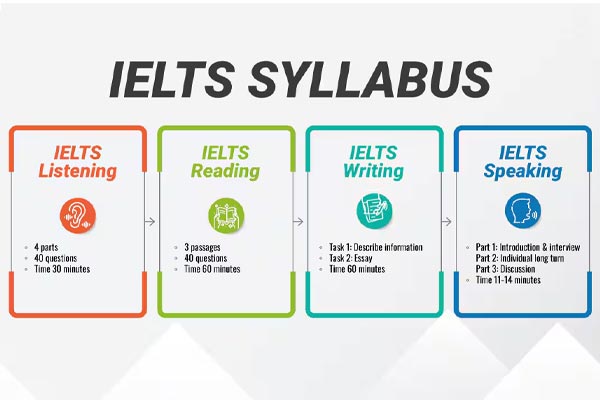The IELTS syllabus for 2025 continues to assess English language proficiency across four core skills: Listening, Reading, Writing, and Speaking. Whether you are planning to study abroad, apply for immigration, or explore work opportunities in an English-speaking country, understanding the updated test structure and syllabus is essential to prepare effectively. In this blog, we explain the 2025 IELTS exam format in detail, along with practical tips to help you build a smart preparation plan for both Academic and General Training versions.
But what exactly does the IELTS exam syllabus 2025 include? How is the IELTS structure 2025 different from previous years? What kind of preparation strategy should you follow?
Let’s break it down, section by section.
What is the IELTS exam syllabus 2025?
The IELTS exam pattern 2025 consists of four components, which remain the same — Listening, Reading, Writing, and Speaking. Each section assesses a specific set of language skills, and the overall test format remains consistent across the Academic and General Training versions.
Types of IELTS exams: Which one should you take?
Choosing the right IELTS version is the first step in your preparation.
Ideal for: Students applying to universities or institutions. Focus: Academic English (graphs, analysis, research-style texts).
Ideal for: Work or migration to English-speaking countries. Focus: Everyday English (letters, advertisements, notices).
Designed for UK visa applicants (Academic or General formats).
Focuses only on Listening and Speaking for UK family/settlement visas.
Section-Wise Breakdown of the IELTS Syllabus
Let’s take a closer look at each component of the IELTS 2025 syllabus.
Listening:
What is the IELTS Listening format in 2025?
- Duration: 30 minutes
- Number of Questions: 40
- Format: 4 audio recordings with increasing complexity
Breakdown:
- Everyday conversation
- Monologue on daily topics
- Group discussion in an academic context
- Academic lecture or talk
Accents included: British, Australian, Canadian, American
- Test your headphones beforehand
- Use the preview time to scan questions
- Focus on keywords and numbers
- Use capital letters for answers
Reading:
What is the IELTS Reading section like in 2025?
- Duration: 60 minutes
- Number of Questions: 40
- Text Types: Academic journals, newspapers, handbooks
- 3 long passages
- May include charts or diagrams
- Mix of short and long texts from real-life sources
- Skim for main ideas, scan for details
- Time management is crucial
- Don’t overanalyse one question
Writing:
What is the format of the IELTS Writing test in 2025?
- Duration: 60 minutes
- Tasks: Two tasks for both Academic and General
- Task 1: Analyse visual data (chart, graph, table)
- Task 2: Formal essay (argument, opinion, or problem-solving)
IELTS General Training Writing:
Tips for Writing:
- Allocate 20 minutes for Task 1, 40 minutes for Task 2
- Stick to the word count (150/250 words)
- Avoid repetition and passive voice
- Always write a clear conclusion
Speaking:
What can you expect in the IELTS Speaking section?
- Duration: 11–14 minutes
- Format: Face-to-face or virtual interview
Part 1: General introduction and basic questions
Part 2: Cue card topic (1-minute prep, 2-minute talk)
Part 3: Follow-up discussion (abstract/analytical questions)
- Be fluent, not perfect
- Don’t memorize answers
- Focus on structure and clarity
- Ask for clarification if needed
Final Thoughts:
The IELTS exam syllabus 2025 remains similar to previous years but focuses more on real-world and academic communication scenarios. Understanding the IELTS 2025 syllabus is key to planning your preparation journey. Whether you’re aiming for Academic or General Training, focus on the IELTS exam structure 2025, know what to expect in each section, and prepare smartly with the right tools.
At Focus Education, we offer personalised coaching for both Academic and General Training IELTS. With expert guidance, regular feedback, and targeted practice, we help you prepare confidently and aim for a higher band score. Start your IELTS journey with Focus.



